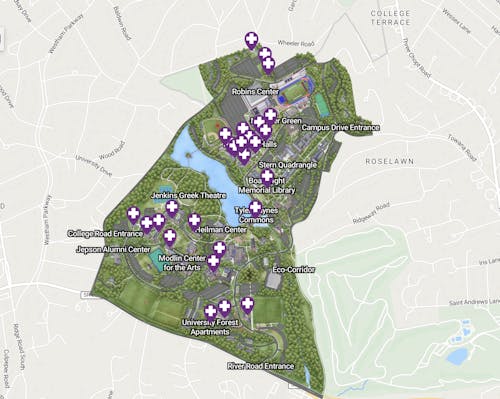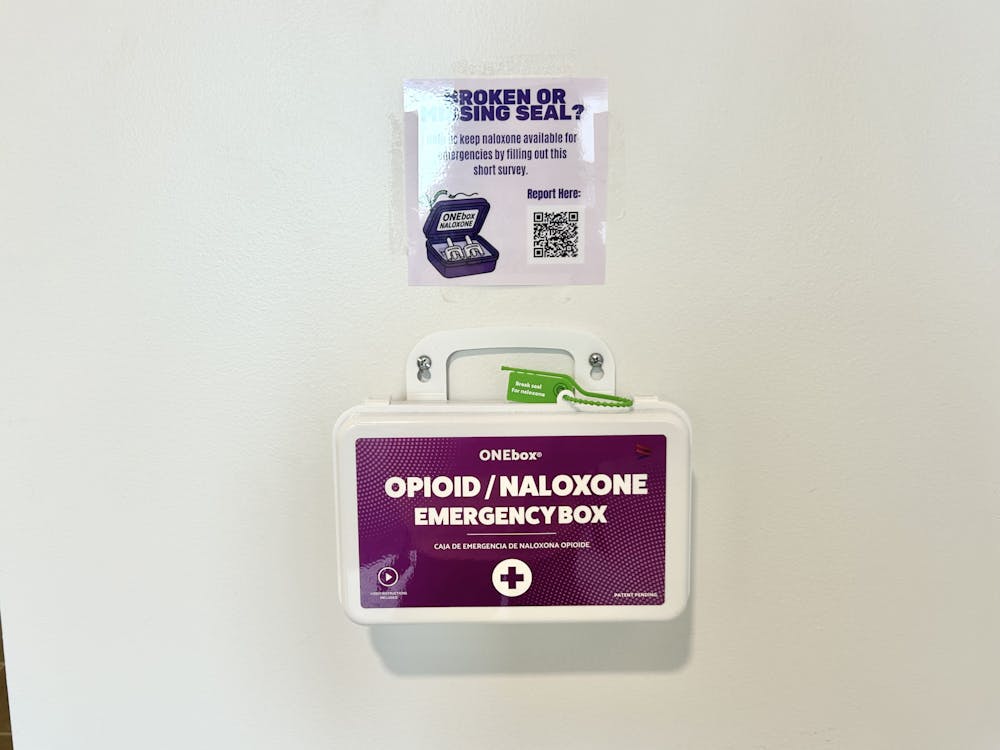As students arrived for the start of a new school year, they began to notice something new: small, purple and white boxes of naloxone across campus.
Naloxone, the generic name of Narcan, is an immediate overdose treatment for opioids, including fentanyl, heroin and morphine. The installations are a part of the Opioid Overdose Prevention Program, known as OOPP, a project started last year by Susannah Carter, ‘25.
“It started as my senior project for health studies,” Carter said. “I attended a rapid Narcan training on campus…and it seemed really incredible that you could save someone’s life in two minutes.”
The kits include instructions for use and personal protective equipment. They have been distributed to residence halls and student hot spots like Tyler Haynes Commons and Boatwright Memorial Library.

Map of naloxone kit locations can be found via the campus map on the SpiderSafe app.
Naloxone works by immediately blocking receptors in the brain that respond to opioids. The nasal spray works similarly to other common medicines, making naloxone simple for anyone to use.
“If you know how to use Flonase, you know how to use Narcan,” Carter said.
In 2023, Richmond’s rate of fatal overdoses was four times higher than the state of Virginia’s, according to OOPP’s information page. That same year, fentanyl was behind 76.4% of Virginia’s fatal overdoses.
Senior Caroline Donohoe helped with the outreach and education side of the project. She discussed how important addressing the stigma of overdose is to this program.
“I did work on developing educational materials about what [the kits] are for and how to use them,” she said. “Now that they’re up, we want to see how perceptions and stigma will change.”
Looking forward, OOPP hopes to change people’s perception of opioid overdoses, and who they happen to.
Enjoy what you're reading?
Signup for our newsletter
“Opioid use is not just someone on the side of the road. We need to recognize that this is a bigger problem than just different pockets of communities around the area,” Courtney Blondino, assistant professor of health studies and OOPP project member, said. “We know students smoke marijuana. Fentanyl can be laced in marijuana and in other drugs, and it doesn’t take much fentanyl for it to be a lethal dose.”
Students have responded positively to the kits. One student said that naloxone is an important resource to have immediately accessible to students.
“I think Narcan boxes are a great life-saving device that should be easily accessible everywhere. Having them accessible and people knowing how to use them is really important,” sophomore Sophia Rodriguez said.
Carter noted how crucial the support she received was in propelling the project forward.
“It really was this incredible student, faculty, and staff network that we have here,” she said. “Every single person that we interacted with over the course of the project was willing to help.”
According to the University of Richmond’s Department of Health Promotion, symptoms of an opioid overdose are difficulty breathing, clammy skin, and convulsions.
Contact news writer Celia Poag at celia.poag@richmond.edu
Support independent student media
You can make a tax-deductible donation by clicking the button below, which takes you to our secure PayPal account. The page is set up to receive contributions in whatever amount you designate. We look forward to using the money we raise to further our mission of providing honest and accurate information to students, faculty, staff, alumni and others in the general public.
Donate Now



